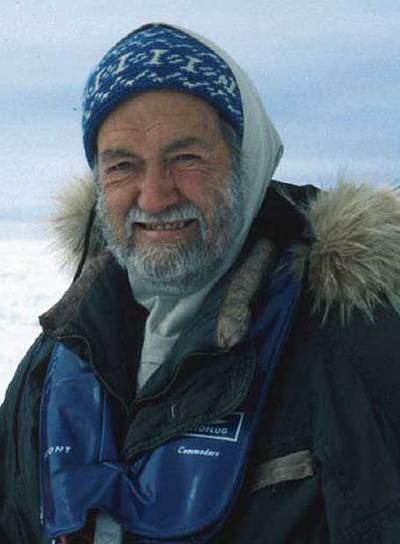Wally Herbert (Walter William Herbert)

Walter Herbert was born into an army family in England who emigrated to Egypt on assignment when he was three. They moved on to South Africa for nine years. He studied at the Royal School of Military Survey, then spent 18 months surveying in Egypt and Cyprus. He travelled back to England through Turkey and Greece, drawing portraits for his board and lodging. In 1955, when Wally Herbert was 21, he carried out surveying in the Antarctic with the Falkland Islands Dependencies Survey, during which he became an expert in dog sleighing. On a journey along the Antarctic Peninsula from Hope Bay to Portal Point, he sledged some 5,000 km. This experience with dogs led him to a job with the New Zealand Antarctic programme, which commissioned him to purchase dogs in Greenland for the Antarctic. There he learnt Inuit methods of dog driving. As leader of an exploration party in the early 1960s, Herbert surveyed a large area of the Queen Maud range and followed Shackleton (1908) and Scott’s (1911) route up the Beardmore Glacier. Denied a request to proceed to the South Pole, his party ascended Mount Nansen and descended a route taken by Amundsen in 1911, thus being the first to retrace these explorers’ traverses. In 1964 he trekked the routes taken by Sverdrup and Cook from Greenland to Ellesmere Island in the Arctic.
From 1968 to 1969, Wally Herbert led the British Trans-Arctic Expedition, a 3,800-mile surface crossing of the Arctic Ocean, from Alaska to Spitsbergen, which some historians had billed as the ‘the last great journey on Earth.’ In July 1968, having crossed 1,900 km of rough drifting ice, Herbert and his team established a camp. Because they could not reach a position where the drift of the trans-Arctic ice-stream was in their favour, they were forced to stay for the winter, as they drifted around the pole. Only when sunlight returned the following year could they continue their journey, finally reaching the North Pole via the Pole of Inaccessibility on 6 April 1969. Their feat was recognised by the Prime Minister, Harold Wilson, as “a feat of endurance and courage which ranks with any in polar history”, and which Prince Philip stated “ranks among the greatest triumphs of human skill and endurance”. In recognition of his polar achievements, Wally Herbert received several honours and awards: among them the Polar Medal and bar; the Founders’ Medal of the Royal Geographical Society, the gold medals of several Geographical Societies, and the Explorers Medal of the Explorers Club. He has a mountain range and a plateau named after him in the Antarctic; the most northerly mountain in Svalbard named after him in the Arctic
Born
- October, 24, 1934
- United Kingdom
Died
- June, 12, 2007
- United Kingdom
- Inverness, Scotland

